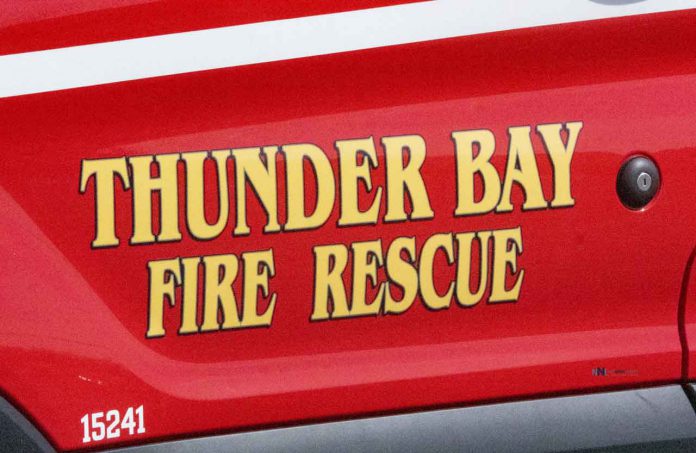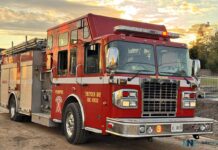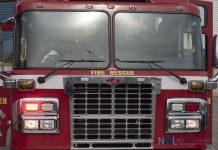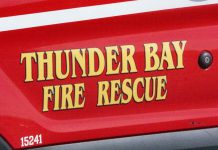Thunder Bay, ON – NEWS – In the early hours of this morning, at around 4:00 AM, Thunder Bay Fire Rescue sprang into action following reports of a residential structural fire on North Hill Street’s 100 block. Their rapid response proved pivotal as they encountered a fully engaged fire in the basement upon arrival, prompting a second alarm for additional support.
A Smoke Alarm Saves a Life
The sole resident of the affected home was alerted to the impending danger by a functioning smoke alarm. Acting swiftly, they evacuated the premises and immediately called 911 from a neighbour’s residence. This quick-thinking move likely saved their life.
Firefighter Efforts
The first pumper crew on the scene wasted no time, advancing a hose line to apply water directly to the fire through a basement window. With remarkable efficiency, they then transitioned inside the building to extinguish the blaze entirely, preventing it from spreading beyond its point of origin. Thunder Bay Fire Rescue’s relentless efforts continued for about two hours, ensuring the fire was fully extinguished and conducting necessary overhaul activities.
Investigation Underway
The cause of the fire remains uncertain at this time, and Thunder Bay Fire Rescue has initiated an investigation to determine its origin.
Massive Response
Six pumpers, an Aerial Ladder, and a Command vehicle rushed to the scene to combat the structural fire, underscoring the dedication and preparedness of the Thunder Bay Fire Rescue team.
A Vital Reminder
In the wake of this incident, Thunder Bay Fire Rescue emphasizes the importance of having working smoke alarms in every home. These small devices can make a life-saving difference by providing early detection of fires. Equally important is the reminder that once you’ve safely exited a burning structure, never re-enter it under any circumstances. Safety should always be the top priority.
This incident serves as a poignant reminder of the critical role that preparedness plays in emergencies. By having a fire plan, functional smoke alarms, and the knowledge of what to do in such situations, individuals can significantly increase their chances of escaping unharmed. Thunder Bay Fire Rescue continues to urge all residents to prioritize these safety measures to protect themselves and their loved ones in the event of a fire.
What Should You Do to Protect Yourself and Your Family?
A good fire plan for a home should prioritize safety and preparedness. Here’s a step-by-step guide on creating an effective fire plan:
1. Install Smoke Alarms:
- Install smoke alarms in every bedroom, outside each sleeping area, and on every level of your home. Test them monthly, and replace the batteries at least once a year or as needed.
2. Plan Escape Routes:
- Identify two escape routes from each room in your home, if possible. This could include doors and windows.
- Ensure that escape routes are clear of obstacles and easy to access.
3. Establish a Meeting Point:
- Choose a designated meeting point outside your home where everyone in your household should gather after evacuating.
4. Practice Fire Drills:
- Conduct regular fire drills with all household members. Make these drills as realistic as possible.
- Ensure that everyone knows how to escape using the identified routes and where to meet outside.
- Practice crawling low to the ground to avoid smoke inhalation.
5. Teach Fire Safety:
- Educate your family members, especially children, about fire safety.
- Teach them how to stop, drop, and roll if their clothing catches fire.
- Emphasize the importance of not hiding during a fire; they should get out as quickly as possible.
6. Check Windows:
- Ensure that windows can be easily opened by all family members.
- Consider escape ladders for upper floors if necessary.
7. Close Doors:
- Close all doors behind you as you leave. This can help slow the spread of fire and smoke.
8. Stay Low in Smoke:
- If you encounter smoke while escaping, stay low to the ground where the air is clearer.
9. Call 911:
- Once you are safely outside, call 911 or your local emergency number to report the fire. Provide your address and inform them of any individuals still inside the building.
10. Never Re-enter:
- Stress the importance of never re-entering a burning building for any reason. Leave the firefighting to the professionals.
11. Special Considerations:
- If there are elderly or disabled family members, ensure they have a way to evacuate safely.
- If you have pets, have a plan for their evacuation as well.
12. Fire Extinguishers:
- Have fire extinguishers in key locations, such as the kitchen, and ensure that family members know how to use them.
13. Escape During Sleep:
- Practice waking up to a smoke alarm at night and immediately following your escape plan. Many home fires occur when people are sleeping.
14. Emergency Contacts:
- Keep a list of emergency contacts and important documents in a fireproof box or safe, easily accessible during an evacuation.
15. Review and Update:
- Regularly review and update your fire escape plan, especially if there are changes in your household or home layout.
Remember that the goal of a fire plan is to ensure everyone’s safety. Regular practice and clear communication are essential to making sure that all family members know what to do in the event of a fire.






